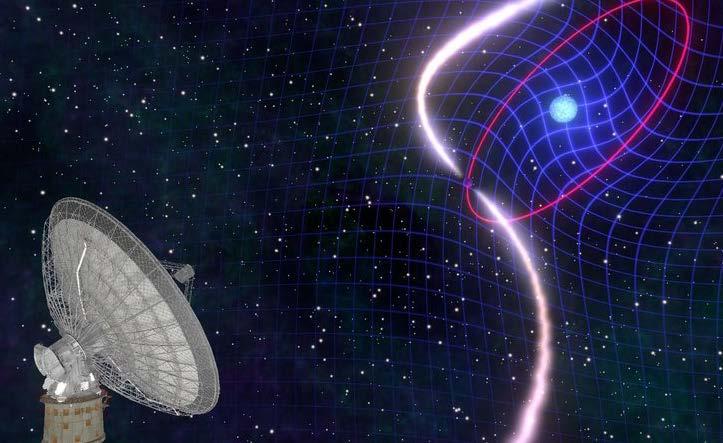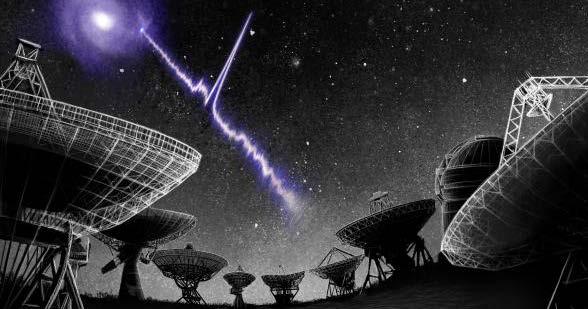
8 minute read
News from SKA Pathfinders
from Contact 03
An international team of astronomers, including one of SKAO’s Project Scientists and using SKA pathfinders, has for the first time detected the dragging of space-time in a distant binary star system, something previously only measured around Earth with satellite experiments.
According to Einstein’s general relativity, the rotation of a massive object drags the space-time in its vicinity. Using a pulsar orbiting a white dwarf and two SKA pathfinders – CSIRO’s Parkes Telescope and the Molonglo Observatory Synthesis Telescope – the team were able to detect for the first time this swirling of space-time around the fast-rotating object.
New and upcoming radio telescopes such as MeerKAT and the SKA will play a central role in understanding how Einstein’s theory is at play in such natural laboratories. “With the SKA expected to detect more exotic binary systems like this one, we’ll be able to investigate many more effects predicted by general relativity” concluded Dr Evan Keane, co-author and scientist at the SKA Organisation in the UK.
Commenting on Evan’s work, SKAO Science Director Prof. Robert Braun added “The SKA is still some years away, but our team of astronomers at SKAO are continuing their research and contributing to groundbreaking work with international teams.” The results, published in Science, involved scientists at the Max Planck Institute for Radio-astronomy in Germany, SKA Organisation, Swinburne University in Australia, Auckland University of Technology in New Zealand and University of Aarhus in Denmark.
Read more on the SKAO website: https://www.skatelescope.org/news/astronomers-detect-distant-space-time-dragging-first-time/.
By SKAO. Source: Max Planck Institute for Radio Astronomy

The white dwarfpulsar binary system PSR J1141- 6545 discovered by CSIRO’s Parkes radio telescope – an SKA pathfinder – which was used for the study.
Credit: Mark Myers/ARC Centre of Excellence for Gravitational Wave Discovery (OzGrav), Australia
EVN DISCOVERY DEEPENS MYSTERY OVER FAST RADIO BURSTS
Telescopes in the European VLBI Network (EVN), one of the SKA pathfinder facilities, have observed a repeating Fast Radio Burst (FRB) in a spiral galaxy similar to our own.
This FRB is the closest to Earth ever localised and was found in a radically different environment to previous studies. The discovery, once again, changes researchers’ assumptions on the origins of these mysterious extragalactic events, which were first discovered just over 10 years ago and last for only a fraction of a second.
On 19th June 2019, eight telescopes from EVN teamed up to simultaneously observe a radio source. This source was originally discovered the year before by the CHIME telescope in Canada – another SKA pathfinder. The team, led by Benito Marcote from the Joint Institute for VLBI ERIC, was able to conduct a very high resolution observation with EVN. During five hours of observations the researchers detected four bursts, each lasting for less than two thousandths of a second. The resolution reached through the combination of the telescopes across the globe, using a technique known as Very Long Baseline Interferometry (VLBI), a technique the SKA will make full use of once built, meant that the bursts could be precisely localised to a region of approximately only seven light years across. This localisation is comparable to an individual on Earth being able to distinguish a person on the Moon with the naked eye!
Read more on the JIVE website here: https://www.jive.eu/repeating-fast-radio-burst-spiral-galaxy-deepens-mystery-where-these-signals-originate
Source: JIVE

Above: Eight antennas from the EVN in the UK, the Netherlands, Germany, Italy, Sweden, Poland, Latvia and China were involved in observing a repeating Fast Radio Burst (FRB) in a spiral galaxy similar to our own.
Credit: JIVE
STAR CLUSTER PROVIDES TELLTALE SIGNS OF GALACTIC WIND
An international research team has used pulsar data from CSIRO’s Parkes telescope, one of the SKA pathfinders, to study the Milky Way’s magnetic field and find clues pointing to the galactic wind. The team’s results were published in Nature Astronomy.
The galactic magnetic field plays an important role in the evolution of our galaxy, but its behaviour is still poorly understood. Using pulsars located in a tight cluster of stars in our galaxy’s halo called 47 Tuc, the team discovered an unexpected strong magnetic field in the direction of the cluster that could be explained by an interaction with what’s called the galactic wind - a fast-moving wind of charged particles and gas thought to be coming from the supermassive black hole at the centre of our galaxy. The existence of this galactic wind has never been proven before.
Galactic magnetic fields can influence star formation and help establish the presence of a flow of gas from the galactic disk to its surrounding halo. In the future, South Africa’s SKA precursor telescope MeerKAT, and the SKA itself, will provide even better measurements which could confirm the presence of the Galactic wind and investigate its properties, as well as having the capability to observe other similar clusters and corroborate the results.
Source: Max Planck Institute for Radio Astronomy
LOFAR PIONEERS NEW WAY TO STUDY EXOPLANET ENVIRONMENTS
Using the ASTRON-led Low Frequency Array (LOFAR) radio telescope, astronomers have discovered unusual radio waves coming from the nearby red dwarf star GJ1151.
The radio waves bear the tell-tale signature of aurorae caused by an interaction between a star and its planet. The radio emission from a star-planet interaction has been long predicted but this is the first time astronomers have been able to discern its signature. This method, only possible with a sensitive radio telescope like LOFAR, an SKA pathfinder, opens the door to a new way of discovering exoplanets in the habitable zone and studying the environment they exist in. The team expects this new method of detecting exoplanets will open up a new way of understanding their environment. “The long-term aim is to determine what impact the star’s magnetic activity has on an exoplanet’s habitability, and radio emissions are a big piece of that puzzle,” said Dr Vedantham. “Our work has shown that this is viable with the new generation of radio telescopes, and put us on an exciting path.” The results were published in Nature Astronomy.

Artist impression of a red-dwarf star’s magnetic interaction with its exoplanet.
Credit: Danielle Futselaar (artsource.nl)
Red dwarfs are the most abundant type of star in our Milky Way, representing an estimated 80% of stars in the galaxy, but much smaller and cooler than our own Sun. This means for a planet to be habitable, it has to be significantly closer to its star than the Earth is to the Sun. Red dwarfs also have much stronger magnetic fields than the Sun, which means, a habitable planet around a red dwarf is exposed to intense magnetic activity. This can heat the planet and even erode its atmosphere. The radio emissions associated with this process are one of the few tools available to gauge the potency of this effect.
“The motion of the planet through a red dwarf’s strong magnetic field acts like an electric engine much in the same way a bicycle dynamo works. This generates a huge current that powers aurorae and radio emission on the star,” says Dr Harish Vedantham, the lead author of the study and a Netherlands Institute for Radio Astronomy (ASTRON) staff scientist.
The team is using images from the ongoing survey of the northern sky called the LOFAR Two Metre Sky Survey (LoTSS) of which Dr Tim Shimwell, ASTRON staff scientist and a co-author of the study, is the principal scientist. “With LOFAR’s sensitivity, we expect to find around 100 of such systems in the solar neighborhood. LOFAR will be the best game in town for such science until the Square Kilometre Array (SKA) comes online,” says Dr Shimwell.
By Alice Spruit, ASTRON
ASTRONOMERS DETECT BIGGEST EXPLOSION IN THE HISTORY OF THE UNIVERSE
Scientists studying a distant galaxy cluster have discovered the biggest explosion seen in the Universe since the Big Bang. The discovery was made using NASA’s Chandra X-ray Observatory, ESA’s XMM-Newton as well as two SKA pathfinder facilities: the Murchison Widefield Array (MWA) in Western Australia and the Giant Metrewave Radio Telescope (GMRT) in India.
The blast came from a supermassive black hole at the centre of a galaxy in the Ophiuchus galaxy cluster, about 390 million light-years from Earth. It released five times more energy than the previous record holder.

Above: This extremely powerful eruption occurred in the Ophiuchus galaxy cluster, which is located about 390 million light years from Earth.
Credits: X-ray: NASA/CXC/Naval Research Lab/Giacintucci, S.; XMM:ESA/XMM; Radio: NCRA/TIFR/GMRTN; Infrared: 2MASS/UMass/IPAC-Caltech/NASA/NSF
Director of MWA Prof. Melanie JohnstonHollitt, from the Curtin University node of the International Centre for Radio Astronomy Research, said the event was extraordinarily energetic.
“We don’t know why it’s so big,” she said. “But it happened very slowly – like an explosion in slow motion that took place over hundreds of millions of years.”
It was so powerful it punched a cavity in the cluster plasma – the super-hot gas surrounding the black hole.
The cavity had been seen previously with X-ray telescopes, but scientists initially dismissed the idea that it could have been caused by an energetic outburst, because it would have been too big. The researchers only realised what they had discovered when they looked at the Ophiuchus galaxy cluster with radio telescopes, underscoring the importance of studying the Universe at different wavelengths.
“The radio data fit inside the X-rays like a hand in a glove,” said co-author Dr Maxim Markevitch, from NASA’s Goddard Space Flight Center. “This is the clincher that tells us an eruption of unprecedented size occurred here.”
The discovery was made using MWA’s original configuration of 2048 antennas, but the telescope has since benefitted from a major upgrade doubling its size, which should make it 10 times more sensitive. Similarly, the archival data from the GMRT, that helped provide higher resolution for a more detailed look at the cluster, are from 2008. “This is a great example of how archival data from the GMRT can be mined for interesting new finds and justifies the efforts and resources NCRA has put in to preserve every bit of interferometric data taken with the GMRT since its inception,” said Prof. Yashwant Gupta, Director of the Indian National Centre for Radio Astrophysics (NCRA). “Today, with the upgraded GMRT, we can do much better with observations of this kind thanks to a much larger bandwidth.”
The results were published in The Astrophysical Journal and a preprint is available here.
Source: ICRAR










